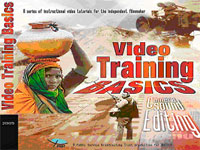Videos
The Video Training Basics, a series of instructional video tutorials for the independent filmmaker
This series of instructional “how to” videos will introduce potential and practicing filmmakers to the elements of independent documentary film production, particularly to its processes and techniques.
 This series of instructional “how to” videos will introduce potential and practicing filmmakers to the elements of independent documentary film production, particularly to its processes and techniques.
This series of instructional “how to” videos will introduce potential and practicing filmmakers to the elements of independent documentary film production, particularly to its processes and techniques.
With the increasing availability of low cost technologies for both production and post-production, the training material will help fulfill a vital need in democratizing the non - print media. Empowering individuals and communities to produce content will help ensure the generation of a more localized content specific to the needs, values and lifestyles of the individual content provider and the community which he or she represents.
Through this series of training modules, UNESCO and its partner, the Public Service Broadcasting Trust (PSBT), intend to support this process by facilitating the democratization of content and by providing basic and easily comprehensible self-training materials that are inexpensively distributed to potential content creators. They will provide a basic, conceptual and technical understanding of the uses and techniques of audio-visual film production with a focus on the independent documentary.
If this documentary was used as the framework for the training content is because it represents the most easily distributed, accessible and complete genre to present an alternative case or perspective to that presented by commercially driven or state-run television.
This project aims to equip a generation of filmmakers and viewers with the basic tools that are essential in the communication process to use the audiovisual medium effectively in order to demonstrate the plurality of views and issues that form civil society.
The Video Training Basics are divided into three modules:
Camera Module
The Camera, the first in the three-part series on Video Training Basics, looks at some simple yet important principles to follow while using a video camera. From hand-cranked cameras to silent movies, the journey of the cinematic image has been a long one, but the rules have remained largely unchanged.
Using the camera creatively cannot be easily slotted into do's and don'ts video. The camera is often compared to the human eye. Yet, what a difference between how the eye creates a perspective and how we use the camera to perform like the eye.
Sound module
Recording sound, the second in the series, explores some basic principles of recording sound especially on location.
In the creative actualization of reality on video, sound is an integral element. Sound waves bounce and reverberate in varying ways under different circumstances, a characteristic that makes it difficult to record. While the human ear distinguishes between sounds, the mic does not. It is dangerous to believe badly recorded sound can be rectified later or that anyone can record sound. Recording sound is a specialized skill.
Editing module
Editing, the thrid in the series, points to the basic grammar of putting together a series of recorded moving images into a coherent cinematic sentence. It is during the editing process that a film develops its narrative style and structure, bringing together form and content. It is often a lengthy process that needs patient attention to detail, and constant reworking.
Formats available: VHS (Pal, Secam, NTSC) and DVD (Pal, Multizones)
Total duration (of three modules): 79’
To order for a copy of the Video Training Basics, send an e-mail request, indicating your name and postal address and video format preference (DVD or VHS), to:
Video Training Basics
Programme for Creative Content
Communication Development Division
UNESCO
e-mail: creativecontent@unesco.org
OUT OF STOCK FOR THE MOMENT
| Windows Media File | |
| Website | |
| Format of video | DVD |




